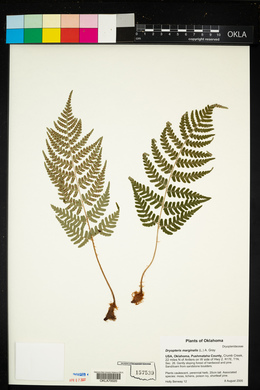Dryopteris marginalis
|
|
|
|
Family: Dryopteridaceae
Marginal Wood Fern, more...marginal woodfern
[Aspidium marginale (L.) Sw., moreAspidium marginale var. elegans J. Rob., Dryopteris marginalis f. davenportii (Eastm.) A. Prince ex Weath., Dryopteris marginalis f. tripinnatifida (Clute) Weath., Nephrodium marginale (L.) Michx., Nephrodium marginale f. davenportii (Eastm.) Floyd, Thelypteris marginalis f. elegans (J. Rob.) Weath.] |
Leaves monomorphic, green through winter, 30--100 × 10--25 cm. Petiole 1/4--1/3 length of leaf, scaly at base; scales in dense tuft, pale tawny. Blade bluish green, ovate-lanceolate, pinnate-pinnatifid to 2-pinnate at base, leathery, not glandular. Pinnae ± in plane of blade, lanceolate; basal pinnae lanceolate, slightly reduced, basal pinnules longer than adjacent pinnules, basal basiscopic pinnule longer than basal acroscopic pinnule; pinnule margins shallowly crenate to nearly entire. Sori near margin of segments. Indusia lacking glands. 2 n = 82. Rocky, wooded slopes and ravines, edges of woods, stream banks and roadbanks, and rock walls; 50--1500 m; Greenland; N.B., Nfld, N.S., Ont., Que.; Ala., Ark., Conn., Del., Ga., Ill., Ind., Iowa, Kans., Ky., Maine, Md., Mass., Mich., Miss., Mo., N.H., N.J., N.Y., N.C., Ohio, Okla., Pa., R.I., S.C., Tenn., Vt., Va., W.Va., Wis. Dryopteris marginalis is an eastern North America endemic. Even though this species hybridizes with 10 other species, and some of these hybrids are fairly common, D . marginalis is not known to be involved in the formation of any fertile polyploid. Hybrids can be detected by malformed spores and the nearly marginal sorus position.
Perennial fern 30 cm - 1 m tall Leaves: clustered, stalked, firm, leathery, bluish green (even in winter), 20 - 50 cm long, 10 - 25 cm wide, widest just above base, egg-lance-shaped in outline, but pinnately compound twice except for very tip where only deeply pinnately lobed. The leaves are typically hairless on the upper surface, sparsely hair-like scaly on the lower surface, never glandular-hairy, and the main "midrib" (rachis) has a lengthwise groove along its upper surface. Rhizome: ascending to erect, scaly. Leaf stalks: 10 - 20 cm long, with dense tufts of slender, pale, orange-brown scales at base and scattered smaller scales above. Spores: 64 per sac, brownish, all of one kind, single-sectioned (monolete), oblong or kidney-shaped, and coarsely wrinkled or with folded wings. The spores give rise to the gametophyte (the sexual phase of the plant), which is small, green, heart-shaped, hairless or often with glands or hairs, and sits above the ground. Similar species: When fertile fronds are present, Dryopteris marginalis is quite easy to distinguish from other species in the genus since the spore clusters (sori) are located right along the edges of the leaf divisions instead of between the veins and edges. In general leaf shape and arrangement, the closest similar species would be D. celsa, D. clintoniana, D. cristata, and D. goldiana, but none of those species have their sori located along the leaf edges. Habitat and ecology: Somewhat rare overall, especially in our more western sites, but fairly common in Berrien County, Michigan, where it grows on shaded slopes of old dunes. Occurence in the Chicago region: native Notes: This species is endemic to eastern North America. It does not produce any fertile hybrids, but does produce several sterile hybrids, including D. x algonquinensis (cross with D. fragrans), D. x burgessii (cross with D. clintoniana), D. x leedsii (cross with D. celsa), D. x neowherryi (cross with D. goldiana), D. x pittsfordensis (cross with D. carthusiana), and D. x slossoniae (cross with D. cristata). These sterile hybrids can be separated from the parent species by the presence of misshapen spores and intermediate characters in leaf morphology. Author: The Field Museum Rhizome ascending to erect; lvs firm, evergreen; petiole 1-2 dm, with a tuft of slender, concolorous, pale reddish-brown scales at the base and smaller, scattered scales above; blade lance-oblong, (2-)3-4.5 נ1-2.5 dm, broadest just above the base, glabrous but with a few hair-like scales, pinnate-pinnatifid to bipinnate, with 15-20 pairs of pinnae, the larger pinnae with mostly 10-15(-18) pairs of segments, the larger segments mostly (0.7-)1-2(-2.5) cm, with 6-9 pairs of veins; sori submarginal, near the sinuses between the teeth; 2n=82. Woods and talus-slopes; Nf. to S.C. and Ga., w. to s. Ont., Minn., Kans., and Okla. Gleason, Henry A. & Cronquist, Arthur J. 1991. Manual of vascular plants of northeastern United States and adjacent Canada. lxxv + 910 pp. ©The New York Botanical Garden. All rights reserved. Used by permission. From Flora of the Indiana Dunes (1930) - Donald C. Peattie T. marginalis (L.) Nieuwland. Fronds smooth and thick, in outline ovate-oblong; pinnae lanceolate, acuminate, the pinnules oblong-scythe-shaped, crowded. (Nephrodium Michx.; Dryopteris Gray; Aspidium Sw.)—A large handsome fern, rare and local in damp woods, Miller and Dune Park, and a little more common east of Michigan City. From Flora of Indiana (1940) by Charles C. Deam This species is, for the most part, restricted to the outcrops of sandstone or nearby residual soils which are the product of sandstone in the southern part of the state. Most of my specimens are from wooded bluffs and slopes along streams. In addition to my collections, it has been reported from Clark, Floyd, Monroe, and Vigo Counties. It has been reported also from the dune area, and on May 30, 1935, R. M. Tryon, Jr. showed me large colonies of it on a north, wooded slope in Memorial Park about a mile east of Michigan City. It is, without question, a native here. A form in which the pinnae are toothed or lobed has been named and has been reported from Indiana. I have a few specimens with some of the pinnae toothed but I do not think it is worth while to name such minor fluctuations. ...... Indiana Coefficient of Conservatism: C = 8 Wetland Indicator Status: FACU |
|
|
|




































































































